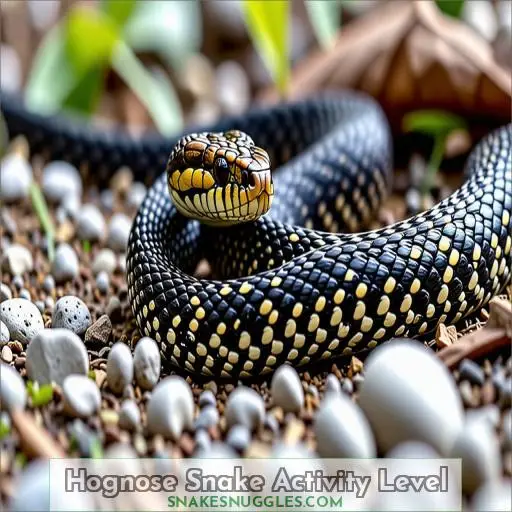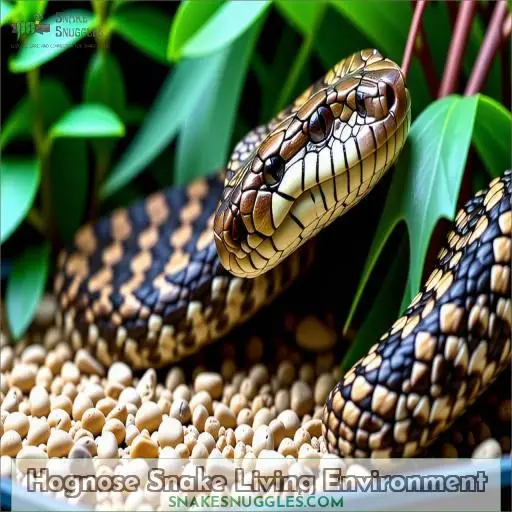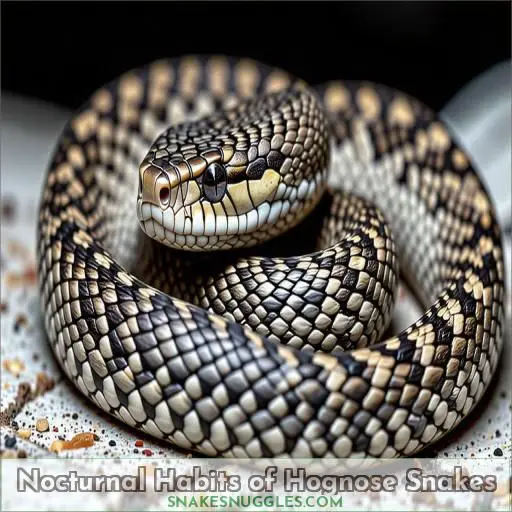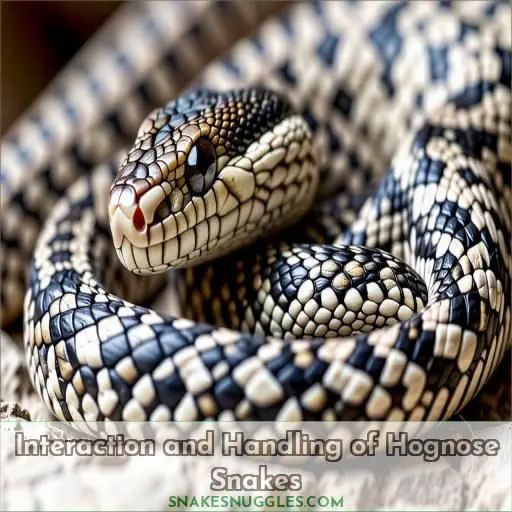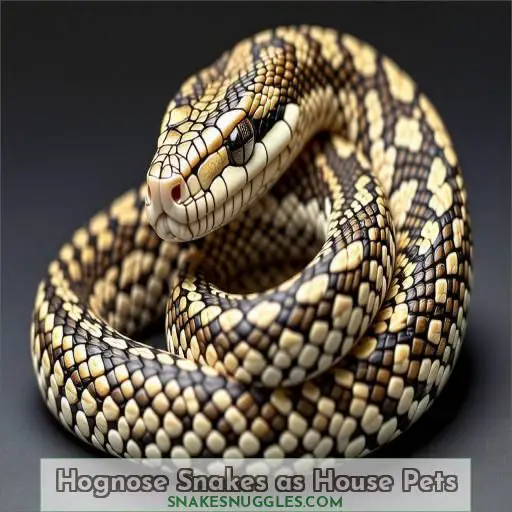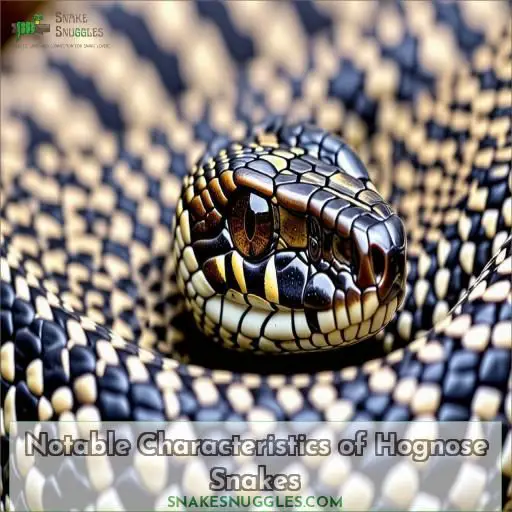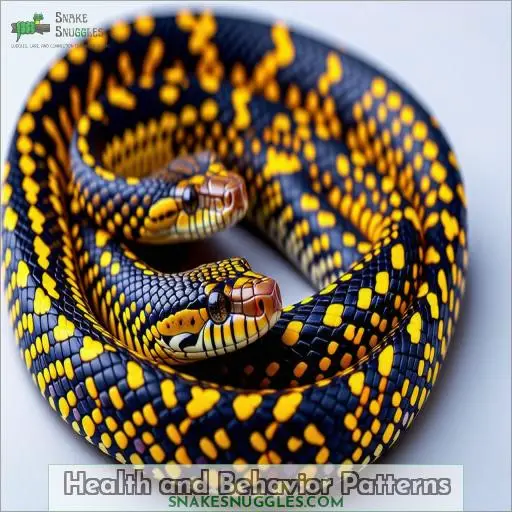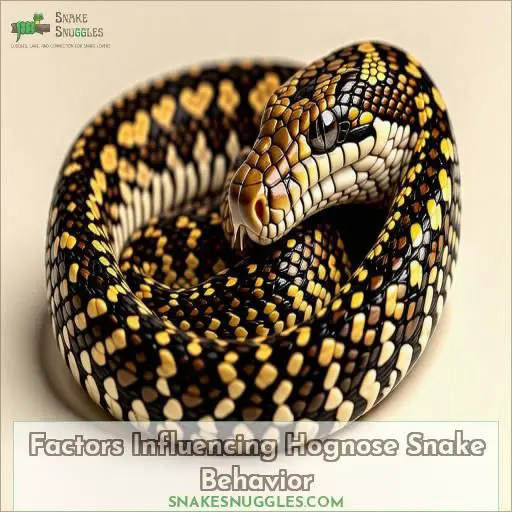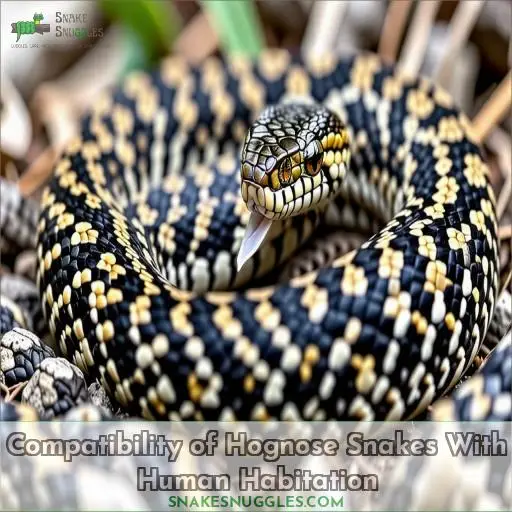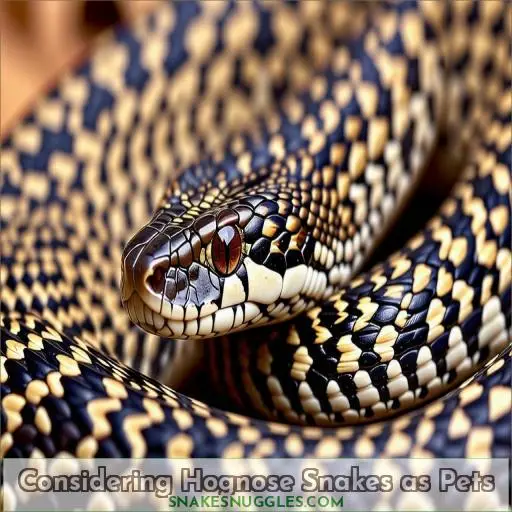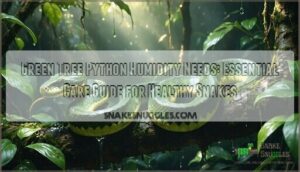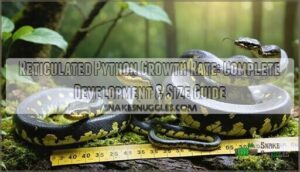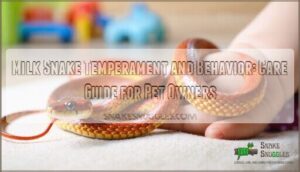This site is supported by our readers. We may earn a commission, at no cost to you, if you purchase through links.
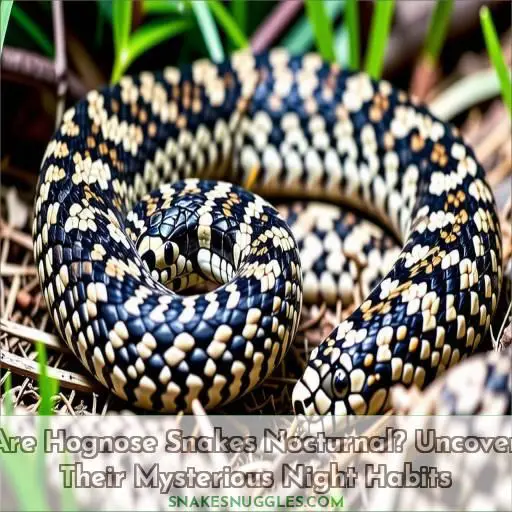 Not exactly.
Not exactly.
While these distinctive snakes with upturned snouts and round pupils are primarily diurnal, their burrowing habits may give the impression of nocturnal behavior.
They’re skilled excavators, spending portions of daylight hours tucked away in soil or leaf litter.
However, proper habitat setup with appropriate light cycles encourages natural diurnal activity patterns.
So, you’ll often spot these unique reptiles out and about during the day – just be prepared for some temporary subterranean disappearances!
Want to learn more about managing their environment for ideal visible activity?
Table Of Contents
- Key Takeaways
- Are Hognose Snakes Nocturnal?
- Hognose Snake Activity Level
- Hognose Snake Living Environment
- Nocturnal Habits of Hognose Snakes
- Interaction and Handling of Hognose Snakes
- Hognose Snakes as House Pets
- Notable Characteristics of Hognose Snakes
- Health and Behavior Patterns
- Factors Influencing Hognose Snake Behavior
- Compatibility of Hognose Snakes With Human Habitation
- Considering Hognose Snakes as Pets
- Frequently Asked Questions (FAQs)
- Are hognose snakes very active?
- Are hognose snakes good to have around the house?
- Do hognose snakes like to be handled?
- Can you keep a hognose snake as a pet?
- How often do hognose snakes need to be fed?
- What is the average lifespan of a hognose snake?
- Can hognose snakes climb or escape their enclosures?
- Are hognose snakes legal to own as pets?
- How much do hognose snakes cost to purchase?
- Conclusion
Key Takeaways
- Hognose snakes are primarily diurnal, meaning they are most active during the day, but their burrowing habits may give the impression of nocturnal behavior.
- Proper habitat setup with appropriate light cycles encourages natural diurnal activity patterns, allowing hognose snakes to be spotted out and about during the day.
- While hognose snakes are diurnal, their round pupils indicate their nocturnality, and they may exhibit specific hibernation habits influenced by seasonal changes.
- Hognose snakes engage in various enrichment options within their enclosure, reflecting their natural instincts, and understanding their dietary preferences, natural predators, and activity patterns during the day provides insights into their fascinating world.
Are Hognose Snakes Nocturnal?
Yes, hognose snakes are primarily nocturnal, meaning they’re most active during the night. Their natural behavior reflects this preference . Hognose snakes tend to exhibit nocturnal behavior due to various environmental and evolutionary factors (Source).
Hognose Snake Activity Level
Hognose snakes are characterized by their diurnal nature, most active during the day .
They demonstrate fascinating behaviors such as digging, reflecting their fossorial tendencies .
While they aren’t nocturnal creatures , their round pupils indicate their diurnal activity .
Hognose snakes engage in various enrichment options within their enclosure, reflecting their natural instincts .
Despite their preference for daylight activity, they may exhibit specific hibernation habits influenced by seasonal changes .
Understanding their dietary preferences, natural predators, and activity patterns during the day provides insights into the fascinating world of the hognose snake .
Hognose Snake Living Environment
You’ll need to provide a suitable living environment for your hognose snake by carefully considering the terrarium size, lighting, temperature and humidity levels, substrate type, and decorations.
Specific requirements include a minimum enclosure size of 48 x 24 x 16 inches for adults.
12 hours of UVB lighting per day with basking temperatures between 90-95°F.
30-50% humidity.
A 4-inch layer of soil-based substrate mixed with leaf litter and hiding spots.
Terrarium Size
You’ll need a minimum 48x24x16 enclosure, but larger is better for these active snakes. Provide sufficient cover, hides, and a temperature gradient.
Lighting, Temperatures & Humidity
Provide your hognose snake with:
- 12 hours of UVB lighting
- 90-95°F basking surface
- 70-75°F cool side
- 30-50% humidity
- Temperature gradient for thermoregulation
- Bioactive décor for burrowing
Substrate (Bedding)
When setting up your hognose snake’s habitat, prioritize a soil-like substrate mix for proper burrowing depth and moisture retention. Incorporate leaf litter for enrichment and odor management benefits.
Decorating the Terrarium
When decorating a hognose snake terrarium, consider:
- Cork rounds and wood
- Magnetic ledges
- Live or artificial plants (Source)
Nocturnal Habits of Hognose Snakes
While hognose snakes are diurnal, meaning they’re most active during the day, their burrowing behavior and tendency to hide can make them appear nocturnal at times.
In captivity, they may adjust their activity patterns based on their environment and feeding schedule.
Hognose snakes have an average lifespan of 10-15 years with proper care.
When threatened, they may flatten their necks, raise their heads, and strike, though they rarely bite.
Understanding their natural behaviors and providing a suitable habitat is key to ensuring your hognose snake thrives in captivity.
Stay tuned to learn more about safely interacting with these fascinating reptiles.
Interaction and Handling of Hognose Snakes
Handling hognose snakes requires patience and proper technique.
Always wash your hands before interacting to avoid transferring scents.
Use a soft, gentle touch and avoid grabbing the snake’s body.
Gently tap the snake’s head with a paper towel roll before picking up.
Never grab the tail, as this can cause stress and injury.
Hognose snakes may flatten their necks and strike when threatened, but rarely bite.
With regular, calm handling, they can become accustomed to human interaction.
Provide enrichment activities like exploring new hides or climbing on branches to encourage natural behaviors and reduce stress.
Prioritize the snake’s safety and comfort during all interactions.
Hognose Snakes as House Pets
Hognose snakes can make fascinating pets for those willing to provide proper care.
Their lifespan of 10-25 years requires a long-term commitment.
While generally docile, hognoses may flatten their necks and strike when threatened, though bites are rare and venom isn’t dangerous to humans.
Shedding occurs every 4-8 weeks, during which time they may refuse food.
Hognoses come in a variety of striking colors like black, tan, orange, and even pink.
Providing a secure, comfortable habitat with proper temperatures, humidity, and hiding spots is essential.
With patience and care, hognoses can become accustomed to gentle handling.
Consult an exotics vet for any health concerns.
Notable Characteristics of Hognose Snakes
Moving from discussing Hognose Snakes as House Pets, let’s explore the Distinctive Characteristics of Hognose Snakes.
These unique reptiles derive their name from their distinctive hog-like upturned noses and are primarily diurnal, meaning they’re most active during the day.
While they possess venom, it isn’t significantly harmful to humans .
In terms of size, Hognose snakes can vary but generally grow to be between 14 to 33 inches long .
Their lifespan ranges from 10 to 18 years in captivity .
They’re native to North America, spanning from southern Canada to northern Mexico, and are known for their fascinating array of colors such as red, brown, and green .
Health and Behavior Patterns
Being aware of common health issues, such as respiratory infections, mouth rot, fungal infections, and parasite infestations, will help you proactively address any emerging concerns with your hognose snake’s well-being.
Additionally, understanding their typical behavioral characteristics, like docile temperaments, defensive reactions when threatened (like neck flattening or mock strikes), and preference for hiding, will enable you to provide an appropriate environment and properly interact with your pet snake.
Common Health Issues
Hognose snakes are prone to several common health issues, including respiratory infections, mouth rot, fungal infections, and susceptibility to mites and ticks. Regular veterinary check-ups are recommended to guarantee their well-being. The diet, habitat, enclosure, care, and handling of hognose snakes play essential roles in preventing and managing these health concerns.
- Respiratory infections
- Mouth rot
- Fungal infections
- Susceptibility to mites and ticks
- Importance of regular veterinary check-ups
Behavioral Characteristics
Hognose snakes are known for their unique defensive behaviors. When threatened, they may flatten their necks, raise their heads, and strike, though they rarely bite. With regular handling, they can become quite calm and docile. Their intelligence allows them to learn and adapt to their environment over time.
Factors Influencing Hognose Snake Behavior
To guarantee your hognose snake’s well-being, you’ll need to adapt its housing conditions precisely. Providing the adequate enclosure size, basking temperatures between 90-95°F (32-35°C), cool zones around 70-75°F (21-24°C), and maintaining humidity levels between 30-50% are essential for replicating its natural environment and promoting ideal health and behavior.
Housing Requirements
Provide proper terrarium ventilation, 4 substrate depth, multiple hides, live plants, and a large water dish for your hognose snake’s health and natural behaviors.
Heat and Light Specifications
Guarantee your hognose snake’s enclosure includes a proper basking spot heated to 90-95°F, UVB lighting placed 6-15” away, maintaining a temperature gradient and 30-50% humidity levels using suitable heat sources .
Humidity Considerations
Maintain ideal humidity levels of 30-50% for western/Mexican hognoses and 50-60% for eastern/southern species to prevent respiratory issues and promote healthy shedding.
Food and Water Needs
To fulfill Hognose snakes‘ needs, offer a varied diet including hairless prey, scent-boosted at times. Utilize a bioactive substrate for enrichment, and maintain appropriate handling durations.
Compatibility of Hognose Snakes With Human Habitation
Hognose snakes are generally compatible with human habitation, but there are a few important considerations.
While their venom isn’t medically significant to humans, it’s best to avoid handling them frequently to minimize stress.
Hognose snakes are nocturnal, so you may only see them at night.
Cohabitation with other species isn’t recommended, as hognoses are solitary and may become aggressive if housed together.
During winter, hognoses may hibernate, requiring a period of cooler temperatures.
With proper habitat setup and minimal handling, hognose snakes can thrive in a home environment.
However, their unique needs require research to guarantee their health and well-being.
Considering Hognose Snakes as Pets
If you’re considering bringing a hognose snake into your home, it’s imperative to understand their nocturnal behaviors and specific care requirements. While hognose snakes are primarily diurnal, meaning they’re most active during the day, they may exhibit some nocturnal tendencies, necessitating an enclosure that provides adequate heating, lighting, and hiding spots to accommodate their natural habits.
Discussion Points
When considering Hognose snakes as pets, focus on aspects like their diet, burrowing behavior, venom, habitat needs, and lifespan for a fulfilling and informed pet ownership experience. (Source)
Nocturnal Hognose Behavior [1
Hognose snakes are primarily diurnal, but may exhibit nocturnal activity, burrowing, and play behaviors. Provide enrichment and monitor hibernation to support their natural tendencies.
Hognose Snake Enclosures [2
Hognose snakes thrive in spacious enclosures with proper substrate, basking zones, and enrichment. Maintain cleanliness and consider bioactive setups with live plants for a thriving pet.
Feeding Hognose Snakes
Hognose snakes are carnivores. Offer appropriately sized prey like mice, rats, quail eggs, anoles, frogs, and toads. Supplement with calcium and vitamin powders. Scent picky eaters’ prey.
Frequently Asked Questions (FAQs)
Are hognose snakes very active?
Curiously, these snakes are crepuscular, meaning they’re most active at dawn and dusk. You’ll find hognose snakes exhibiting their characteristic upturned snouts while hunting or basking during these times, but they generally rest throughout the night and heat of the day.
Are hognose snakes good to have around the house?
Not really. Hognose snakes aren’t recommended house pets. They’ve specific environmental needs – proper heating, humidity, and enclosure size – that most homes can’t provide. While beginner-friendly, these snakes thrive best in a controlled vivarium with the right habitat setup.
Do hognose snakes like to be handled?
Like kids with a favorite toy, hognose snakes don’t always take well to handling initially. With gentle, positive interactions, though, these docile snakes can become calm, even enjoying the bonding experience.
Can you keep a hognose snake as a pet?
Yes, you can keep hognose snakes as pets. With proper housing, temperature, humidity, and feeding, these docile snakes make engaging companions for experienced reptile enthusiasts.
How often do hognose snakes need to be fed?
You should feed hatchling hognose snakes every 3-4 days, and adults every 4-5 days. Vary their diet with appropriately sized rodents, eggs, anoles, frogs, and toads.
What is the average lifespan of a hognose snake?
Hognose snakes have an average lifespan of 15-20 years with proper care. You’ll need to provide a suitable habitat, varied diet, and regular veterinary check-ups to maximize their longevity.
Can hognose snakes climb or escape their enclosures?
Like Harry Houdini, hognose snakes can be escape artists. Their small size and agility allow them to squeeze through tight spaces, so secure enclosure tops are essential.
Are hognose snakes legal to own as pets?
Yes, hognose snakes are legal pets in most areas, though local laws may vary. Always research regulations before acquiring one as a pet.
How much do hognose snakes cost to purchase?
From head to tail, hognose snakes captivate with affordability – you’re looking at $50 to $150 for a pet-friendly specimen. Care and setup costs add up, but these feisty drama queens are budget-friendly beauties.
Conclusion
Uncovering the mysterious night habits of hognose snakes, you’ll discover these fascinating reptiles live in an intriguing twilight zone between diurnal and nocturnal existences.
While primarily active during the day, their burrowing tendencies occasionally lead to subterranean disappearances, ensuring their nocturnality remains delightfully unpredictable.

